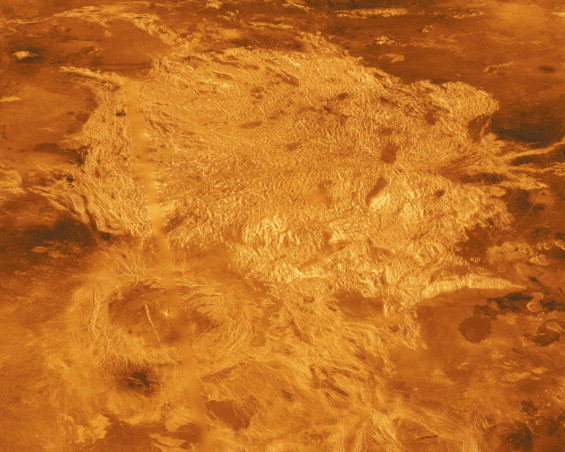
NASA / JPL
Detailed mapping of one of the oldest terrains on Venus has revealed a giant impact structure of a type never before seen on any terrestrial planet. Oddly, the keys to understanding it came from studying craters on two icy moons of Jupiter.
Venus is the least understood of the rocky planets because its thick atmosphere obscuring its surface. Radar has enabled scientists to identify some 1,000 impact craters; however, unlike craters on the Moon, Mercury, and Mars, which were formed in the first 2.5 billion years of the solar system, none of those on the Venusian surface can be dated back to that early time. The oldest might be about 1 billion years old. Moreover, the largest early craters on the Moon, Mercury and Mars are more than 1,500 kilometers (900 miles) across; all of the young Venusian craters are smaller than 300 kilometers.
But the newest discovery might hail from much earlier days. Vicki Hansen (Planetary Science Institute) found the possible crater while leading an effort to map the oldest type of terrain on Venus, known as tesserae. These regions are highly disrupted and deformed, and although how they formed has been under debate, their formation occurred at least 1.5 billion years ago. Known only on Venus, tesserae can span hundreds to thousands of kilometers, and they cover up to 10% of the planet’s surface.

Lopez et al. / Journal of Geophysical Research: Planets 2024
While mapping these regions, the team was surprised to find that one of them, the Haastte-baad Tessera, contains a circular, multi-ringed structure that’s 1,500 km (900 miles) wide. No one had seen anything like it before.
“The beautiful concentric structures were very different from the rest of the tesserae,” says Hansen. “When nature gives you patterns like that which are so obvious, you know they have a story to tell.”
If the structure were an impact crater, then it’d be more than five times the size of the next-largest one known on Venus — a size that fits well with massive impactors flying around the the young solar system. That possibility led Hansen and her fellow mapper Ivan Lòpez (Rey Juan Carlos University, Spain) to not only examine the ringed structure itself but also search the solar system for anything like it.

NASA
They found nothing similar on any rocky planet or on the Moon. But they did find similar concentric ring structures on two worlds made of very different stuff: the Valhalla crater on Callisto and the Tyre crater on Europa. Previous study of these two icy moons of Jupiter revealed that both of the craters formed after a large impactor punched through an icy shell floating on an ocean of liquid water.
To deduce how the unique rocky structure formed on Venus, they brought in Evan Bjonnes (Lawrence Livermore National Laboratory and Lunar and Planetary Institute) an expert in modeling planet formation. He’s worked with Hansen and Lopez on the study published in Journal of Geophysical Research: Planets. His mission: to understand the conditions Venus must have had to enable an impact to smash through its surface and splash out liquid rock to make the formations they’d seen.
“This is where it gets really interesting,” says Hansen. Bjonnes modeled effects of different-size objects hitting solid crusts covering lava pools of varying thickness. The team found that a single, large object hitting a hard, 6-kilometer-thin crust could melt the underlying layer, splashing chunks of “solidified scum” to make the tessera. But a single impact couldn’t simultaneously make the ring structure.
Doing that would take a more complex process, Hansen’s team realized. First, an initial impact produced the tessera terrain, leaving a thin crust over a pond of hot lava that the impact’s energy had melted. Then, while the pond was still fluid, a second object hit, shattering the crust and splattering ejecta. That impact threw some of the melt upward — when it fell back down, it formed the multiple-ringed structure.
Two separate impacts on the same spot might seem unlikely, but the site of the first impact would have remained hot for millions of years afterwards, and as Hansen says, “early Venus would have seen a lot of large bolides, because large bolides were winging around our solar system.”
Venus researcher Anna Gülcher (Caltech), who was not involved in this study, says she is “quite excited about this work,” particularly the new insight the impact scenario offers on tesserae. “We don’t know what they are or how old they are,” she says. The outstanding mystery that tesserae represent has made them among the highest priorities for new missions being planned to Venus, and studies like this one by Hansen lay the groundwork for explaining their origin.

